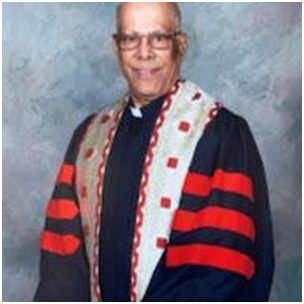 These days of Lenten reflections, especially during the Holy Week, many may recall one of last events in the life of Jesus. St. Luke says: One of the criminals hanging there on the cross hurled insults at Jesus: “Aren’t you the Messiah? Save yourself and us!”. The other one, we know him as St. Demas, known also as the “Good Thief” rebuked him….. “we are getting what we deserve for what we did; but he has done no wrong.” And he said to Jesus, “Remember me, Jesus, when you come as King!”. Jesus said to him, “I promise you that today you will be in Paradise with me.
These days of Lenten reflections, especially during the Holy Week, many may recall one of last events in the life of Jesus. St. Luke says: One of the criminals hanging there on the cross hurled insults at Jesus: “Aren’t you the Messiah? Save yourself and us!”. The other one, we know him as St. Demas, known also as the “Good Thief” rebuked him….. “we are getting what we deserve for what we did; but he has done no wrong.” And he said to Jesus, “Remember me, Jesus, when you come as King!”. Jesus said to him, “I promise you that today you will be in Paradise with me.
The season of Lent in the church calendar lasts for a forty-day period; it is lengthening of daylight in the northern hemisphere before the advent of summer. Jesus spent forty days in the wilderness – the wordless place. Animals – lizards, geckos, toads, jackrabbits, camels, snakes, spiders and meerkats live in deserts they didn’t create. But we humans create our own ‘ incommunicado’ deserts to hunker down!
Millions of followers of Jesus mark these days as the festival of Lent. Sundays are not included in the rigorous self-flagellation of giving up something they love such as smoking, sweets or fixation of using emails and similar social media from Ash Wednesday till the Sunday of Resurrection. Some may engage in new tasks at home, or in the community, such as helping elderly with shopping or shoveling snow.
Following my first year in Edinburgh, since it was prohibitively pricey to return home for summer holidays, I found myself at the Cretegny Farm in the beautiful village ofSaint-Saphorin-sur-Morges, Switzerland. My initial intention was to learn French and my chore included managing about two dozen labourers from bordering nations. After dinner a native French worker helped learn the language. Most of the workers would go to Lausanne for the weekend and as house guest I attended the local church with the family.
On my first Sunday service, we sang Edmond Budry’s celebrated hymn, ‘Thine Is the Glory’.
‘À toi la gloire, O Ressuscité!
À toi la victoire pour l’éternité!
Brillant de lumière, l’ange est descendu,
Il roule la Pierre du tombeau vaincu.’
What an uplifting hymn! I came across this hymn for the first time during an Easter weekend retreat in Troon, a small town in Ayrshire. A few years later, this thunderous song of acclamation, ‘Thine Is the Glory’ was sung at my Ordination Service held at Oxford Mills United Church of Canada in the Ottawa Valley! We all carry similar songs and memories deeply in our hearts that make us mindful of refreshing as well as empowering emotions in our journey of spiritual life.
It is modish to market new versions of theologies. All theologies are crafted by people for the public. No matter what community of faith we belong to, the trajectory of our paths towards the Holy One can be audacious, arduous and at the same time sustaining in order to keep on going in life.
Most people around Jesus did not know him. So, in order to make sure that his followers knew what and who he was all about, he grilled his disciples. The Gospel narratives underscore the identity of a new healer. Two millennia ago, many people believed him while others did not. That scenario is no different today.
Lent, for the faithful, is an opportunity to examine their enthusiasm and integrity to their calling as servants. Many prefer a breezy and syrupy spirituality. Take ’em with a grain of salt. Three decades ago, the late Paulos Mar Gregorios reminded a global Inter-faith gathering to ‘cut down your commercials and improve the product’. The most difficult thing in life for the disciples was to follow Jesus who did not flinch from the foe in fear of the Roman cross. Maybe that’s why Mahatma Gandhi lamented: ‘I like your Christ, but not your Christianity. If it weren’t for Christians, I’d be a Christian.’
As an ordained person, my secretary or family members get phone calls: ‘May I speak to the Reverend please?’. Most folks appear astonished that I have two English theophoric names and one title. Well, when my forebears invited a pack of strange intruders quivering in the Indian Ocean for a cup of tea, and when they overstayed our generous welcome for four hundred years, Yohanan and Mathai got transmuted to John and Mathew!
It is mortifying time after time to hear the word ‘Christ’, which is not a name but a title. Jesus knew his title -Messiah. The four Gospels do not use the Greek term! An angel instructs Mary (Luke) and Joseph (Matthew) to name the child Jesus. The only other name for Jesus is Emmanuel. The very first Gospel of Mark begins: ‘The beginning of the good news about Jesus the Messiah, the Son of God.’
Religions always caved in to a weak-kneed thralldom to a few languages. The Holy One communicates solely in Hebrew, Aramaic, Arabic, Sanskrit, Pali, Latin and even Greek! Translations of the Scriptures into local vernaculars greatly help people to get the message of the faith. It is absolutely not deific for the clergy to show off their slapdash panache in an abandoned, uninspiring language. God did not speak in 17th century King James version – one of the poorest translations! Nor did Jesus.
For better, for worse, Jesus was promoted as ‘Christos’, in a flashy Hellenistic designation of Messiah. Are the Greek term ‘Christ’ and the Hebrew word ‘Messiah’ one and the same? No. Jesus, the Abhishek (from Sanskrit word abhiṣeka – consecration, anointing of a king) might be more orthodox than Jesus, the Christ.
The first Gospel introduces a well-defined identity of Jesus as ‘the Messiah, Son of God’. There are other helpful identities for Jesus such as Son of Man, Son of God, Son of David, etc. Jesus was a care-giver: caring for the exploited, women, children, the poor and those thrown on the margins to fend for themselves. He also asserted to be the true light, the way, the truth and the life.
At a local grocery store checkout line, it is not easy to brush-off a magazine cover with a reputed drawing of Jesus – an upshot of medieval Italian imagination which has little to do with the real image of Jesus of Nazareth. I asked the store manager for his permission to go in and double check an alleged portrait of Jesus. Year after year between Christmas and Easter the print media business decoy “Jesus: Who Do You Say That I Am?”
Mark, an assistant to Peter, who did not know Jesus, was the very first gospel writer. Once when Jesus and his disciples were in the villages near Caesarea Philippi, he posed the question: “Tell me, who do people say I am?” They answered: Some say you are John the Baptist; others say that you are Elijah, while others that you are one of the prophets.
Many scholars have written expansively on the life of Jesus. Each generation highlights a critical examination of the life of Jesus. The only written source of the life of Jesus is Gospel of Mark – an incomplete second-hand narrative that ends with the words ‘they were afraid, because’.
Several years ago, I was invited to speak at a Full Gospel gathering; the prerequisite to be invited to this task was that a guest should be one who believes the Gospel is “full”; full of what? – I never believed that the ‘Gospel’ was full. Reading, studying and living the Good News as incarnate word, the followers of Jesus are ‘the full Gospel’ for today. I turned down the invitation.
Mark 1:1 reads: (The) beginning, a lead-in, of the gospel of Jesus Christ, Son of God. In fact, the compilation of exposé about Jesus received from Peter is not the inclusive gospel; John Mark insists that whatever he replicates about Jesus and his experiences and everything is just an initial approach.
An offspring of the first century heritage of Apostle Thomas who gained a few pointers on religious experiences from the European experiments on the imported faith, my impressions of Jesus are in all imaginable respects different from those of almost everyone I have met. I still love the way Jesus came into my life through my parents, siblings, friends, family and local community of faith.
William Blake shared his idea of Jesus; far more than an idea, – Jesus was a person who became one of us and lived among us. When Jesus asked his disciples: “What about you?” “Who do you say I am?” Peter answered, “You are the Messiah.”
What Mark, Matthew, Luke and John attempted to inform us of Jesus is helpful to know who Jesus was. And yet, no one knows for sure what Jesus looked like except a fictional portrait by a medieval European artist of a handsome Palestinian young man. A young healthy man with long hair and beard in a long beige robe – but that is also just imagination by clueless European medieval artists. Most people in Southwest Asia had brown or dark brown curly hair, brown eyes and brown skin. One of the most household images of Jesus originates from the fourth century Byzantine period with indisputably no historical connection.
Imagine an image in the wackiness of a young Palestinian unorthodox Jewish man menacingly murdered by the Roman soldiers now in the image of an enthroned Roman emperor? A dishevelled, unshaven young man similar to Olympian Zeus dressed in a gold toga- a sloppy outer garment worn by townsfolk in ancient Rome!
In hindsight, all I learned about Jesus was from my purebred pedigree of Apostle Thomas heritage. Was Jesus a hero like Rama? Was Jesus a teacher like Valmiki? Maybe someone like Muhammad? A husky Greek thinker?
Jesus for me was a constant friend who promised to be with me always. The more I read and learned about Jesus, my desire to know more became a life-long fascination to soak up the mysteries of God.
Suddenly during my formative years, I inferred that scholars, especially theologians, might know more about Jesus. I read Presbyterian theology for three years in Scotland, three more years with the United Church of Canada and Roman Catholic schools in Canada, one year in England and four years in the US…. my mustard seed-like faith in God through Jesus remained very much the same as I grasped it at home. Appallingly, I abhor to admit that I lost my ability to read the Scriptures the benign way my parents did!
Also, I spent a few months at Sdot Yam Kibbutz, Caesarea, Israel, in order to take in more about the place Jesus lived. Christianity Today magazine asked me to write about how my time helped me deepen my faith. It didn’t. In the ancient Palestine where Jesus was born, brought up, served his community, crucified on a Roman cross, resurrected and ascended, Jews say ‘Shalom’ (peace) for hello and goodbye and Muslims greet expressing ‘As-salamualaikum (peace be upon you). It is hurtful to hear that ‘The only good Muslim is a dead Muslim’ or ‘People love dead Jews’.
The most famous person in history, with no last name, is known by his first name Jesus. Messiah is his celebrated last name; greatly triggered by global migration and unkempt cultural hegemony, for many, his last name is a Hellenized name. Martin Buber, a Jewish philosopher once said, “Belief of Jesus unites us, belief in Christ divides us”!
Every generation, in fact every faithful follower, scoffer, cynic and naysayer has raised the query: Who is Jesus? The answers keep evolving to satisfy the inquisitive minds of all persuasions.
Each spiritual explorer on a journey of self-discovery must learn to receive, take in and live the uplifting values of critical thinking of life we have inherited. The life of faith is an interminable process for all. A faithful follower in Jesus is neither evangelical nor liberal, neither left nor right! Jesus, the Abhishek asks: ‘Who do you say I am?’
 (The Rev. Dr. John T. Mathew, Mississauga, Ontario, Canada)
(The Rev. Dr. John T. Mathew, Mississauga, Ontario, Canada)
The Reverend Dr. John T. Mathew is an ordained minister in The United Church of Canada and former part-time faculty at Huntington/Laurentian University as well as founding president of Sudbury Interfaith Dialogue. He was awarded the Merrill Fellowship at Harvard University Divinity Schooland served as Pastor-Theologian (Center of Theological Inquiry, Princeton, NJ. He was ecumenical guest minister at St. Machar’s Cathedral, Aberdeen, The Church of Scotland and interim minister in The Presbyterian Church of Aotearoa New Zealand.





